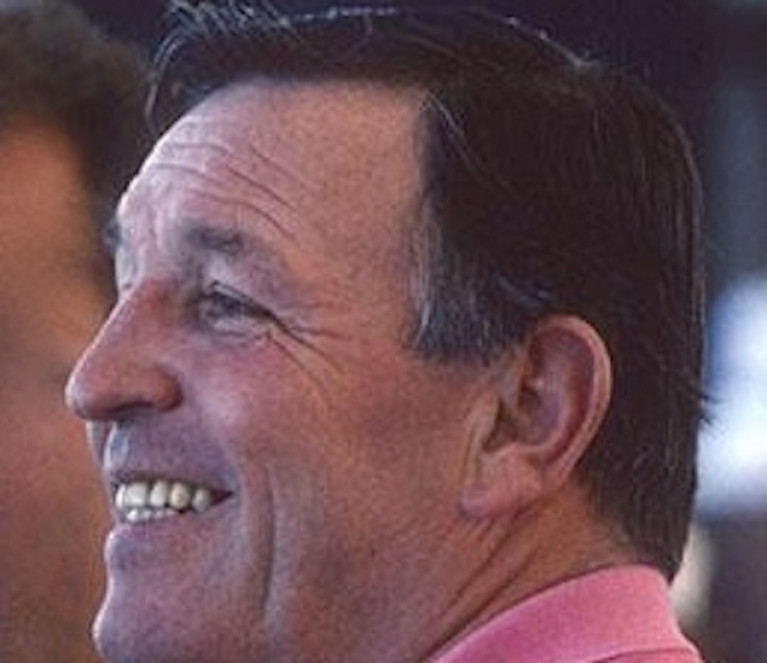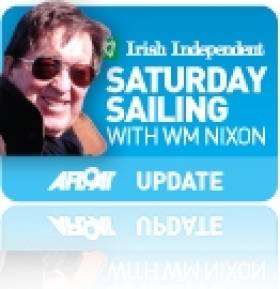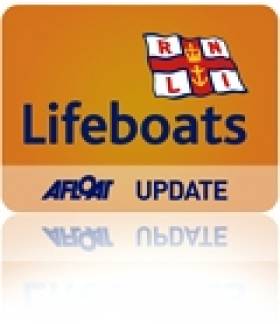Displaying items by tag: Bob Fisher
Bob Fisher 1935-2021
The death in England of the great sailor and sailing writer Bob Fisher at the age of 85 has taken from among us one of the most vibrantly life-enhancing practitioners, innovators, expounders and promoters of our sport.
He had achieved so much in more than 65 years at the sharp end of top-level sailing that a time like this would normally see sadness being offset by a sense of celebration in all that he achieved.
But as his great passion was the America’s Cup – on which he was the unrivalled authority – a considerable poignancy is added through knowing that he has departed just as the first-ever British win in the 170 years of sport’s oldest international contest was becoming a real possibility.
Our thoughts are with his family and friends, and knowing that Bob made many well-remembered visits to Ireland, we know that Afloat.ie readers will have vivid memories of this remarkable man which they may wish to share with us.
W.M. Nixon wrote this piece here in 2013 when Bob had been the star performer at a celebration in the Royal St George Yacht Club in Dun Laoghaire.
From Tom Jobling:
My first encounter with Bob Fisher was way back in the early 70's at Whitstable YC in Kent. It was the occasion of a British GP14 Championship. I had found myself on board the 'press boat' with Frank Chapman (Daily Telegraph) and himself. It was later - I think it was in Yachts & Yachting - that he described the 140 strong fleet as "Dad's Armada”….. Via the GP Magazine “MainSail”, I pulled Bob on this, then to my absolute astonishment, he made comment and mentioned me in his rolling column.
More recently he promoted my debut novel 'Chasing Shadows' both in his international column and among the fraternity. He then wrote a back page review of number two novel 'Arthur's Dead'. We were speaking not that long ago when he requested a copy of my third book...
A wicked sense of humour, an excellent speaker and a great supporter of folk making their way in and around this 'industry' we call sailing. It would have been fascinating to follow his analyses and opinions on the latest episode in the America’s Cup saga in New Zealand, but sadly it is not to be.
Bob Fisher, leading sailing writer and the supreme authority on the America's Cup, brought an inspiring vision of the highest peaks of the sport to the Royal St George YC's 175th Anniversary Champions Celebration last weekend. W M Nixon delves into the backstory of one of global sailing's true greats.
#americascup – There's a dilemma underlying the remarkable career of Bob Fisher. He is one of the best sailing writers in the world. He is probably the very best writer about yacht racing in the world. And he is the undisputed global authority on everything to do with the America's Cup – its history since the first race in 1851, its litany of extraordinary characters with their many wrangles, its technical advances, and its remarkable and sudden ultimate rise to become an event of truly global status during the 34th Series in September 2013 in San Francisco.
The dilemma? Well, The Fish is a true sailing polymath. For sure, he writes vividly about our sport. Yet he is also a talented racing dinghy builder – his own-built boats have won championships to international level. But he is also an extremely good sailor himself. Thus in his long career of writing about sailing, he has probably been a better natural racing sailor than about 98% of the people whose sailing achievement he happens to write about.
All of which explains his "absorbing interest" in the America's Cup, and his ability to produce the defining stories about it. For it is only at the America's Cup that Bob Fisher is best deployed as the reporter, commentator and historian while others do the sailing.
At other events during his long and varied career - he is now 77 - he has often been an active and successful participant in addition to being the man who files the stories at the end of the day's racing. And with this frequent personal involvement in the racing afloat and the apres sailing ashore, sailors see him as one of their own rather than a media person of whom they should be wary. Thus he can come up with the true inside stories which bring his words to life, raising them above reportage to become the vivid defining narrative of sailing as it really is.
Quite how he manages to do it is beyond most folk's imagination. He is doing enough to provide about half a dozen people of more ordinary energy levels with full time careers. Yet although there must have been times when the pace verged on being too hectic to handle, when you meet him participating and reporting in sailing events, or at a special sailing social gathering like the 175th Anniversary Champions Party at the Royal St George YC, it is to find you are undoubtedly in the presence of a great man, but also a man who enjoys it all to the full, with wide and civilised interests in many aspects of human life.
The notion of the 175th Anniversary of the Champions of the George originally came from Johnny Ross Murphy, and when he got friends and fellow members like the master-delegator Brian Craig, plus Derek Jago and Paul Maguire on side, the thing just grew and grew until with a group chaired by Craig, with the efficient Ciara Dowling making sure the nuts and bolts were in place, they worked at a list of who was eligible to be there.
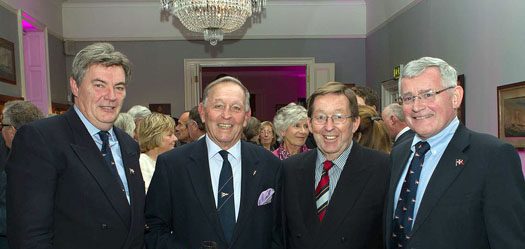
At the Royal St George YC 175th Anniversary Champions Night were (left to right) Don O'Dowd (Rear Commodore (Sailing) R StGYC), Bob Fisher, Winkie Nixon, and Commodore Liam O'Rourke. Photo: Gareth Craig
They managed to go back 62 years, and the final total was 597 major winners of one sort or another, from Dublin Bay champions right up to ten Olympic sailors. On the night, the target figure of 250 attendees had been long since surpassed, and with diligent research they had unearthed some top performers from a very long time ago. Yet it was also very much of today, for even as we reviewed the achievements of 175 years, we were also thinking of RStGYC member Adrian Lee already on his way to establishing the new course record with his Cookson 50 in the 360-mile mile Dubai to Muscat Race, which had started that morning – his success raised the RStGYC major achievement tally to 598 almost before the party was over. At the same time, fellow member Damian Foxall was in Le Havre awaiting the start of the Transat Jacques Vabre 2013 as co-skipper on the MOD 70 Musandam-Oman, but Foxall had to go through frustrating days of waiting as the raced wasn't to start until Thursday November 7th.
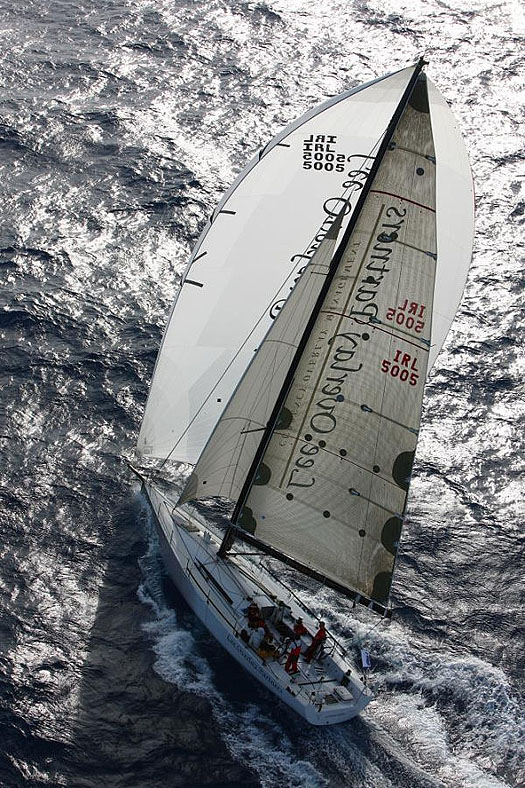
Even as the RStGYC 175th Anniversary Champions Party was under way, club member Adrian Lee was bringing the major achievements list up to 598 with his success in the Dubai-Muscat Race 2013 with his Cookson 50 Lee Overlay Partners. Boat and owner were already in the list with their overall win in the inaugural RORC Caribbean 600 Race in 2009. Photo: Tim Wright
It was quite a night in Dun Laoghaire, and with some crews reunited after more than three decades, there was a lot of catching-up to be done and news to be exchanged. So it says everything about Bob Fisher's ability to convey the new excitement of the current America's Cup that he was able to get the full attention of people in their sea of nostalgia, with his presentation provided an excellent spicing for an evening which would otherwise have been just too totally club-focused.
Sharing the round table at the inter-speeches supper with The Fish, we found topics covered were wide ranging and not necessarily entirely about boats and sailing. But nevertheless it is Bob's boat-owning history, and his uses of his boats, with which the ordinary sailing Joe can most readily identify.
The word is that just about all the Fisher myths are gloriously true. He did indeed absolutely have to sell his own-built championship-winning Fireball at a major event in Switzerland in the 1960s immediately after winning and before departing the hotel, as he and his crew had neither the money to pay the hotel bill (which was enormous, this was Switzerland after all), nor the funds to get themselves home.
He did indeed win his first race at his birthplace of Brightlingsea in Essex at the ripe old age of two years and three months (he was skipper, working mid-cockpit, while his father was detailed off to be the helmsman). And currently at his adopted home port of Lymington on the western Solent, he does indeed co-own with Barry Dunning the 1895-built 40ft Solent One Design Rosenn, the sole survivor of what was probably the world's first one design keelboat class.
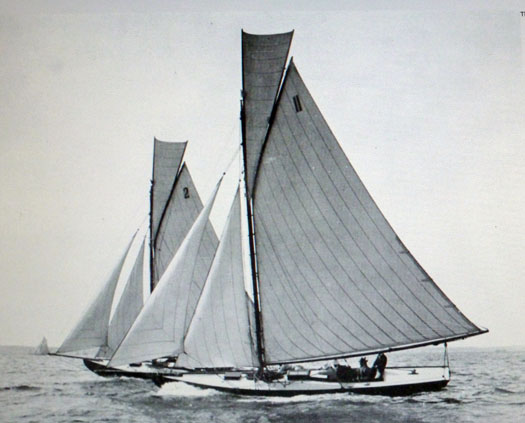
The Solent One Designs in their prime in 1895. They were probably the world's first proper one design keelboat.
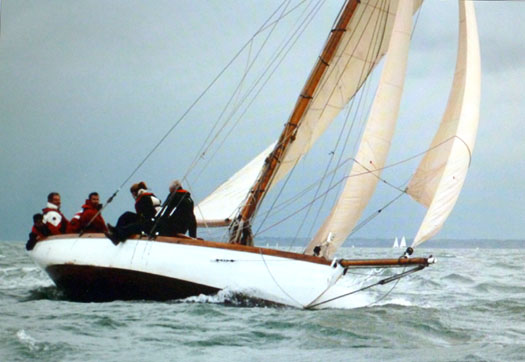
The survivor – Rosenn (Bob Fisher and Barry Dunning) is the sacred relic of the Solent OD.
Thus it's likely that Bob and I were the only two members of the Old Gaffers Association at the 175th anniversary party in the George, as he now owns two gaffers, having given in to his crew's demand that while they can go along with gaff rig, sometimes they'd like to sail a newer boat. So he has obliged them by getting a boat three years younger than Rosenn, a lovely little Fife boat built 1898 which he has in Scotland in readiness for next year's 40th Anniversary Scottish Series, an event with which Bob has been closely associated since its inception.
It's the Scottish Series of 1992 which provides me with the most vivid image of Bob Fisher. Back in the 1980s, he was sailing consultant to the BBC soap Howard's Way, which was about the people – some good, some less so – running an expanding boatyard on the Hamble. To keep the series alive, the producers were looking for a new storyline which would take things in a believable direction, yet provide fresh excitement and business and technical problems with which a wider audience could identify.
Bob suggested that they should get the "yard" to start developing the building of a new-style Ultra Light Displacement Boat, a boat which would be big enough to provide accommodation of family cruising appeal, yet allied to a performance which would, in the ideal ULDB conditions, attract flat out racing types keen for sheer speed. The theory was that the human challenge in a project so far removed from the orthodox European boat type would create its own dynamic and drama.
He was given 48 hours to put the idea in a more concrete form. Now it so happened that some time earlier, he and Tony Castro had been doing a China Sea Race on a Castro-designed 40ft ketch, and though they could get her above ten knots on a good reach, hitting 11 seemed to be an insurmountable barrier. So in their frustration some very rough ideas were sketched out for a ULDB which would simply keep on increasing speed as the breeze built off the wind.
The rough drawings had been put away in a drawer and forgotten about, but after this script conference, Bob immediately phoned Tony Castro and asked him if he could find those drawings, and if so could he develop them up into a workable proposition for the day after tomorrow. More than a little midnight oil was burnt, but Castro came up with the goods, and the result was Barracuda, the 45ft prototype of the ULDB which in production went through various name changes, and was finally series built by Sadler Yachts as the Sadler Barracuda 45, with 19 being produced between 1985 and 1989.
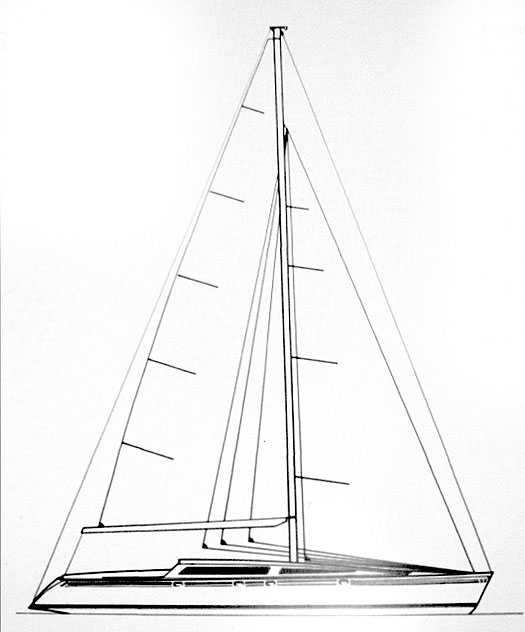
The above-water profile of the Sadler Barracuda 45 looked so normal it was a wolf in sheep's clothing, with the rig as shown only hinting at the fact that enormous masthead kites could be flown when conditions suited.
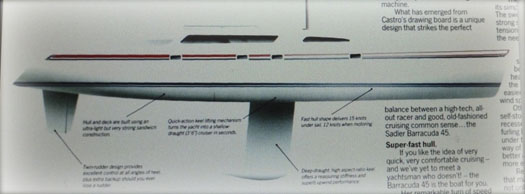
The hull profile gave a clearer indication of the boat's true character as a ULDB. The production boats had a hydraulically-raised keel, but Bob Fisher's prototype had a fairly straightforward heavily ballasted and very deep centreboard which was raised by a 3:1 tackle inside the centreboard case which was led to a winch on the cabintop. Two members of the crew were selected for the end-of-day centreboard-lifting grind with a double grip handle, and timed. The all-time record of 63 seconds was achieved by Bob and his exact contemporary Steve Lemon at Tarbert – "we wanted to get into the Islay Frigate asap"
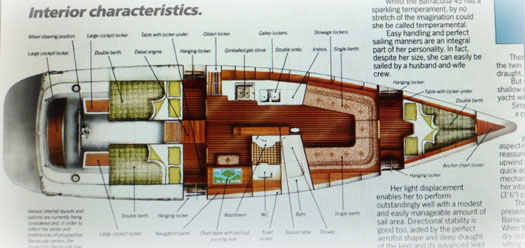
The accommodation layout of the production Sadler Barracuda 45 suggests that the builders were unable to resist filling every corner, whereas a true ULDB will have minimalist accommodation, kept strictly admidships. Although few if any of the buyers of the 19 production boats went for the bath option, their boats all came out at least a ton heavier than Bob Fisher's own Barracuda of Tarrant.
They were a complex build project, with a hydraulically lifting bulb keel which in theory came up far enough for the boat to dry out level, tri-podded on her keel and twin rudders. And with so much space in the roomy hull around the keel housing, they even suggested fiilling an under-utilised gap on the starboard side with a miniature bath, but it's thought that few if any owners availed of this option.
But the timber-built prototype Barracuda of Tarrant herself certainly did the business in developing the storyline for Howard's Way, and she also provided Bob and his wife Dee with ten extraordinary and hugely enjoyable years of active ownership in which they covered tens of thousands of miles thanks in no small part to Dee's exceptional organisational abilities, and her willingness to ensure personally that the boat was at the desired venue and race-ready when Bob arrived in from covering some major sailing event elsewhere in the world.
It says much about the boat's versatility that in 1989 she proved ideal for the two-handed Round Britain and Ireland Race. Sailed by Bob with Robin Knox-Johnston, she scorched round the 2000 mile course to such good effect that she won her class without recourse to handicap, and finished ahead boat-for-boat of the boats in the next two classes above. It made for a change from a previous participation by Bob in this race, when he and Les Williams raced an 80-foot maxi whose sails were so heavy that in each stopover port, they'd to organise a farewell party so that guests could be spirited aboard the big boat in order to help with raising the mainsail.
But Barracuda by contrast provided the perfect combination of long-legged performance with manageable handling loads on both sheets and helm. Thus she frequently made the annual trek round Land's End and north to the Clyde for the Scottish series, and 1992 was a classic example. The main start for the feeder race to Tarbert was from Gourock, and I was crewing for my brother in his Belfast Lough-based Sigma 33. Back in 1992, the Sigma 33s were superbly fulfilling the Offshore One Design ideal, and heading south for Ailsa Craig on a beam reach in a brisk westerly, as the sun set we were streaking out past the Garrock Heads with at least 16 Sigma 33s in line abreast under spinnaker to leeward, and a dozen or so others in close attendance.
Offshore racing gets interesting when the sun sets, particularly so in one designs, for once the sun is gone, you're not allowed to luff. With 16 boats in line and competition intense in the Sigma 33s, there was more than a bit of mighty roaring (our skipper, my own brother, amazed me with his invective towards the boat next to us), leading in turn to shouted debates above the roar of the bow-waves as to how you define sunset on sailing water surrounded by mountains.
But then a great silver wraith came sweeping past as though the Sigma 33s were standing still, and all were briefly silent in admiration. It was Barracuda. Having started quite some time after us, she was zooming south in conditions she loved under an unbelievably large masthead gennaker, with the other boats in her class – some quite substantially larger – left many miles astern.
It was a magic vision in the special light of a long Scottish evening of late Spring. And it was made even more remarkable in that it seemed as though The Fish was sailing her single-handed. For there he was, unmistakable at the helm, his wonderboat perfectly under control with her twin rudders and sails beautifully trimmed, yet set up in such a way that the crew could retreat below for a mug of something hot as the cold Scottish night set in.
Bob and Dee's crews on Barracuda always seemed to be recruited from central casting to have strong characters to match their skipper. So it was entirely in keeping with the boat's style to imagine that they should have decided the skipper could be left on his own to steer the boat to match the setup of sails which briefly had the sheets made fast.
And in Barracuda's rapid passing, it left us the abiding image of Bob Fisher, stately at the wheel, monarch of all he surveyed, happily guiding his beloved dreamship as she swept onwards into the gathering night, with the glorious prospect of yet another wonderful sailing season stretching into the months ahead.
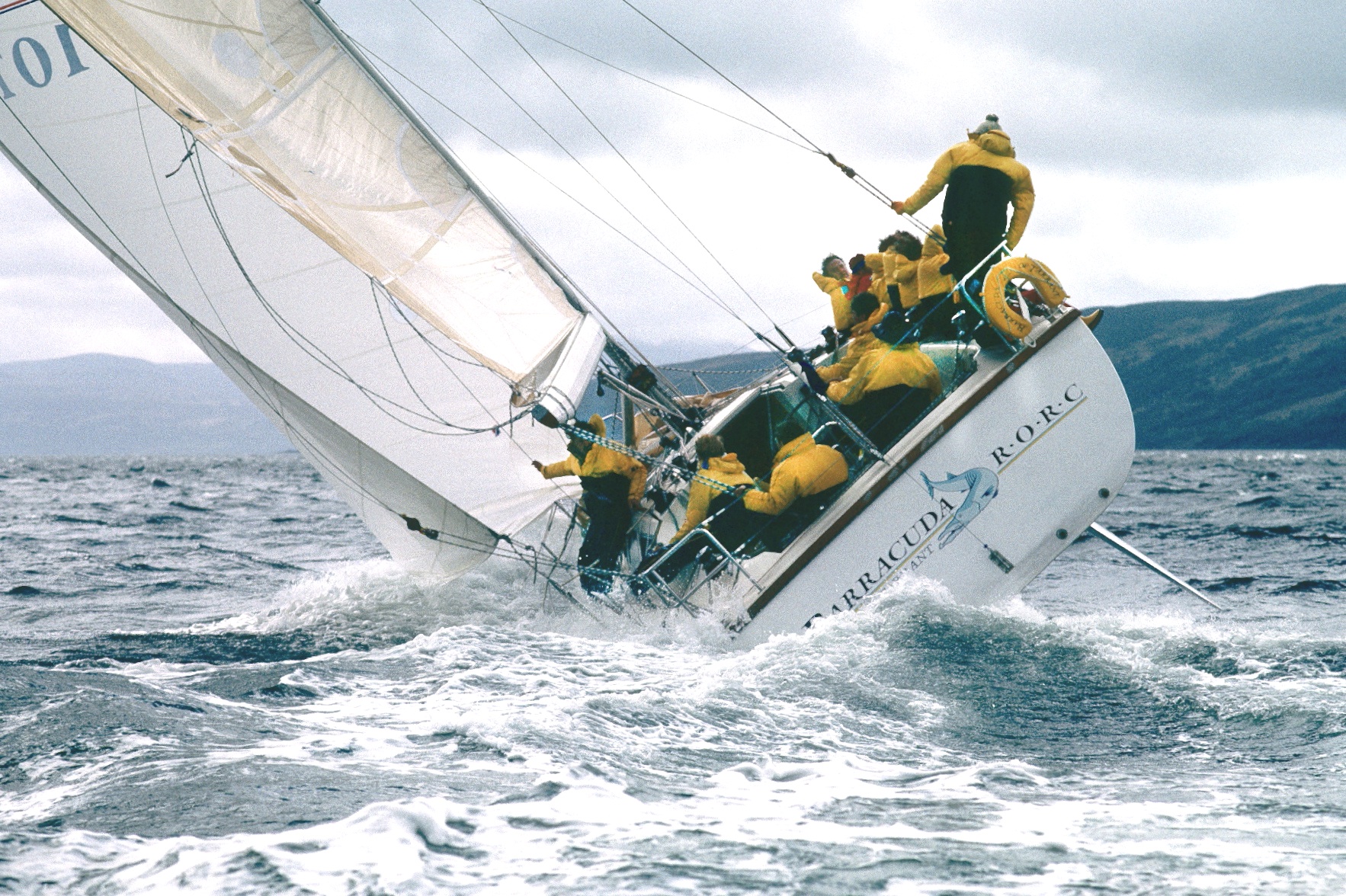
The mighty machine – Barracuda of Tarrant at the Scottish Series 1986. Twenty years before twin rudders became mainstream for large broad-sterned boats in Europe, Tony Castro incorporated them on Bob Fisher's new ULDB. In these squally conditions, a standard broad-sterned yacht of 1986 would have been spinning round to look at herself at frequent intervals. But with the skipper comfortably ensconced at the wheel under his famous black sou'wester, Barracuda tracks as though on rails, with her weather rudder completely clear of the water while her lee rudder is doing the business in a vertical position of maximum efficiency. This design of 29 years ago is still ahead of the game, and it's reckoned a boat built to the same lines and concept, but using the latest construction methods, would be one very potent machine today, Photo: www.patrickroach.com
Fisher Entertains By the Lee in Aid of the RNLI (Photos here!)
#SAILING BY THE LEE – Maritime journalist Bob Fisher entertained over 200 guests today at the annual RNLI "Sailing by the Lee" Lunch 2012 in Cork. SCROLL DOWN FOR PHOTOS BELOW BY BOB BATEMAN.
The large crowd from the maritime community in Cork gathered at the Maryborough Hotel and Spa in Cork for the ninth annual Sailing by the Lee lunch. Kindly supported by Port of Cork and Electric Bar/Restaurant, the event was a huge success with well known faces from the maritime world and Cork's social scene gathering to raise funds for Kinsale and Crosshaven RNLI stations in their work saving lives at sea. €11,650 was raised to go directly towards operations at both stations.
The highlight of the lunch was special guest, international marine journalist Bob Fisher, who had flown in from the UK for the event. Following; an introduction via Skype from Canada by International Marine Architect Ron Holland, Bob recalled his experiences over some 70 years as a world renowned journalist, capturing history unfolding in the worlds of ocean & inshore racing, cruising and the friendships inevitably made.
During the lunch, RNLI Patron Donal McClement paid a special tribute to Bob on his remarkable career, "I wish to acknowledge Bob's absolute dedication; commitment and enthusiasm in representing those connected to the sea, in bringing the thrills and excitement of events such as the Admiral's and America's Cup back to us at home and capturing the ongoing challenges and adventures of the international maritime community."
Bob Fisher is best known for capturing the America's Cup throughout the years and has published extensively on this and other leading events.
Familiar well known faces who attended on the day included Donal McClement, Peter & Marie Crowley, Conor & Mauritta Doyle, Anthony & Sally O' Leary, Vinny O' Shea, Naval Captain Bob Scarret, Port of Cork's Capt McCarthy, Alan Barton, John P O' Gorman and Tom McSweeney.
Speaking after the event, RNLI Governor Peter Crowley stated:-
"Our sponsors and supporters for this year's event have been extremely generous and we are very grateful to them, particularly given the challenging economic climate. In particular, I would like to thank Port of Cork and Electric Bar & Restaurant, South Mall. We are delighted to have Bob Fisher and his wife, Dee with us this year-with their help, we raised sufficient funds today to replace and update all crew lifejackets at both the Kinsale and Crosshaven Stations."


























